Introduction
Salesforce Flow is a powerful automation tool that allows users to create and execute complex business processes. With Salesforce Flow, users can automate repetitive tasks, streamline workflows, and ensure consistency in data entry and management.
One of the key features of Salesforce Flow is the use of Flow Variables. Salesforce Flow Variables are placeholders for data that can be used throughout a flow. They allow you to store and manipulate data, and make decisions based on that data. Flow Variables can be used to capture user input, store information from records, or perform calculations based on existing data.
The ability to use Flow Variables in Salesforce Flow is essential for building effective and efficient automation processes. By understanding how Flow Variables work and how to use them, users can create robust and dynamic flows that meet their business needs. In the following sections, we will explore the different types of Flow Variables, how to create them, and how to use them in Salesforce Flow.
Types of Salesforce Flow Variable
Salesforce Flow offers several types of Flow Variables, each designed to handle a specific type of data. Understanding the different types of Flow Variables is essential for creating effective and efficient flows. Here are the most common types of Flow Variables:
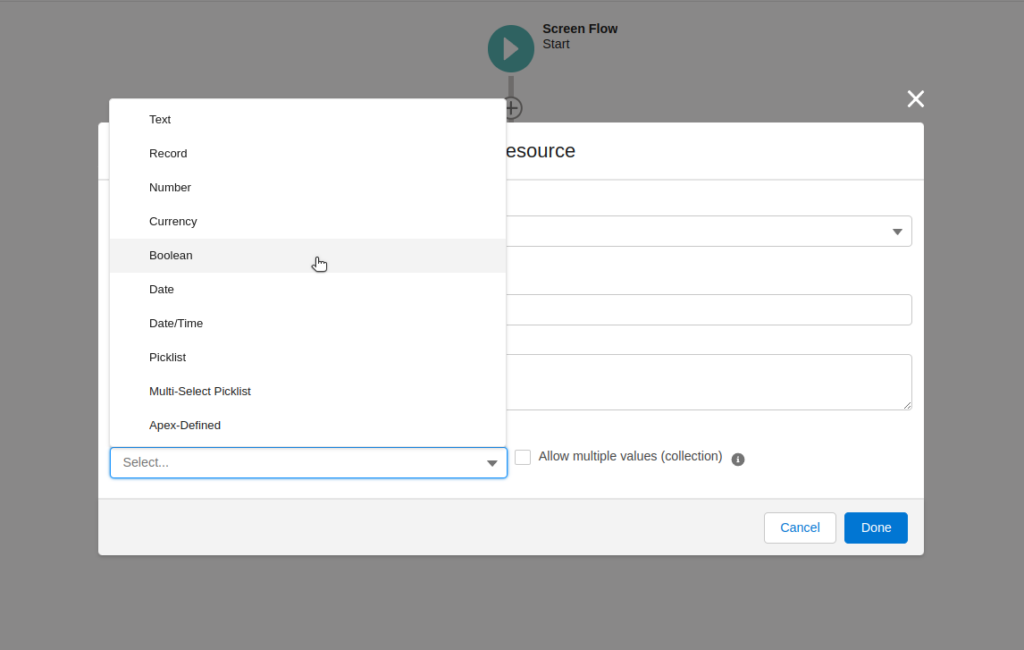
- Text Variables: Text Variables are used to store alphanumeric data, such as names, addresses, or email addresses.
- Record Variables:
- Number Variables: Number Variables are used to store numeric data, such as quantities, prices, or percentages.
- Currency Variables:
- Boolean Variables: Boolean Variables are used to store true/false values, such as whether a record has been approved or not.
- Date Variables:
- Date/Time Variables: Date/Time Variables are used to store date and time values, such as appointment times or due dates.
- Picklist Variables:
- Multi-Select Picklist Variables:
- Apex Defined Variables:
- Collection Variables: Collection Variables are used to store multiple values of the same type, such as a list of accounts or a group of related records.
By using the appropriate type of Flow Variable, you can ensure that your flow is processing and manipulating data in the most efficient and effective way possible. In the next section, we will explore how to create Flow Variables.
Creating Flow Variables
Creating Flow Variables in Salesforce Flow is a straightforward process. Here are the steps to create a Flow Variable:
1.From Setup, enter Flows in the Quick Find box and click Flows then New.

2.In the Flow Builder, Select a flow type where you want to create the Flow Variable and click Create. (But here, avoid choosing Record-Triggered Flow, because it requires additional setup steps)
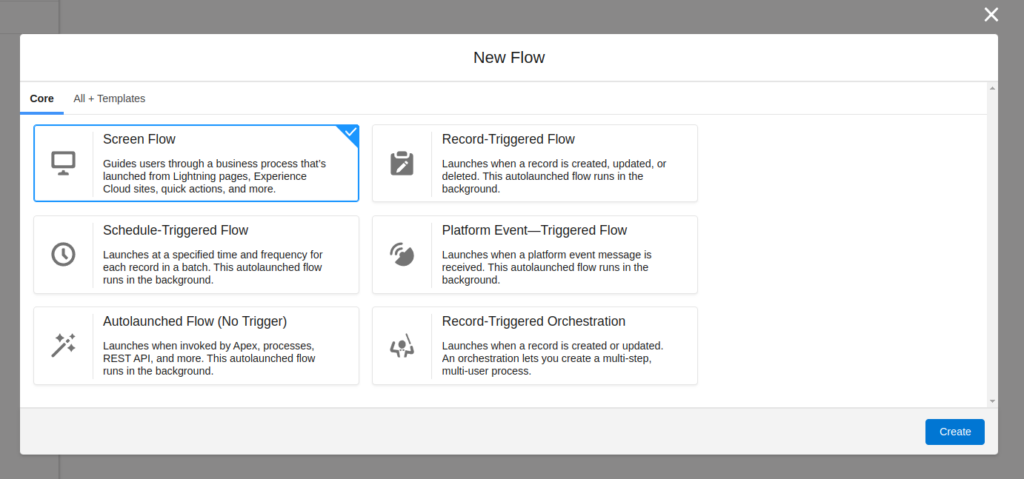
3.Click on Toggle Toolbox icon  to display the Toolbox.
to display the Toolbox.
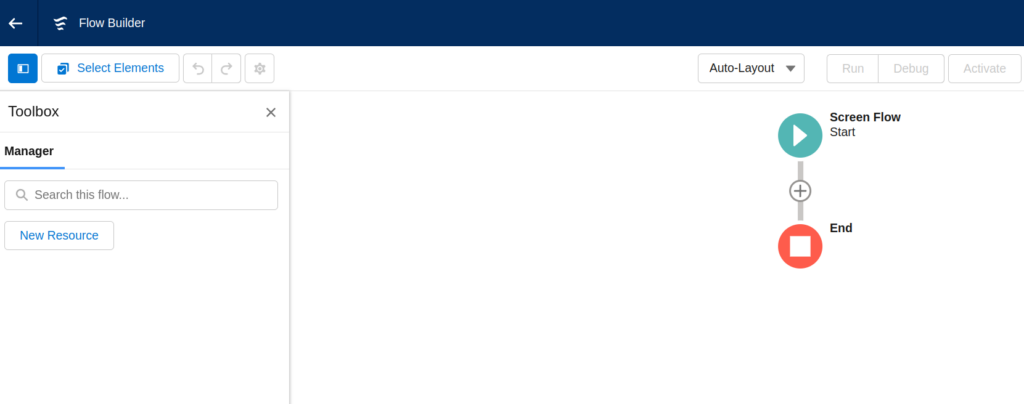
4.To add variable, Click on the New Resource button in the Properties pane.
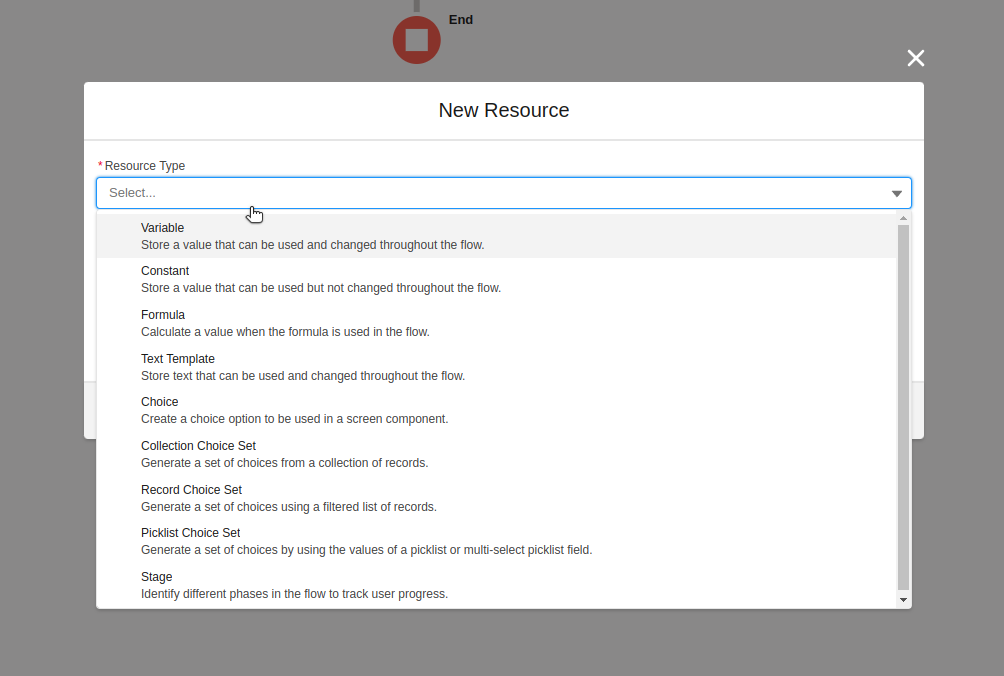
5.Choose the type of variable you want to create from the drop-down list then click Done.

6.Enter a name for the variable in the “Name” field. Use a clear and descriptive name that indicates what the variable is used for, then Click Done to create the variable.
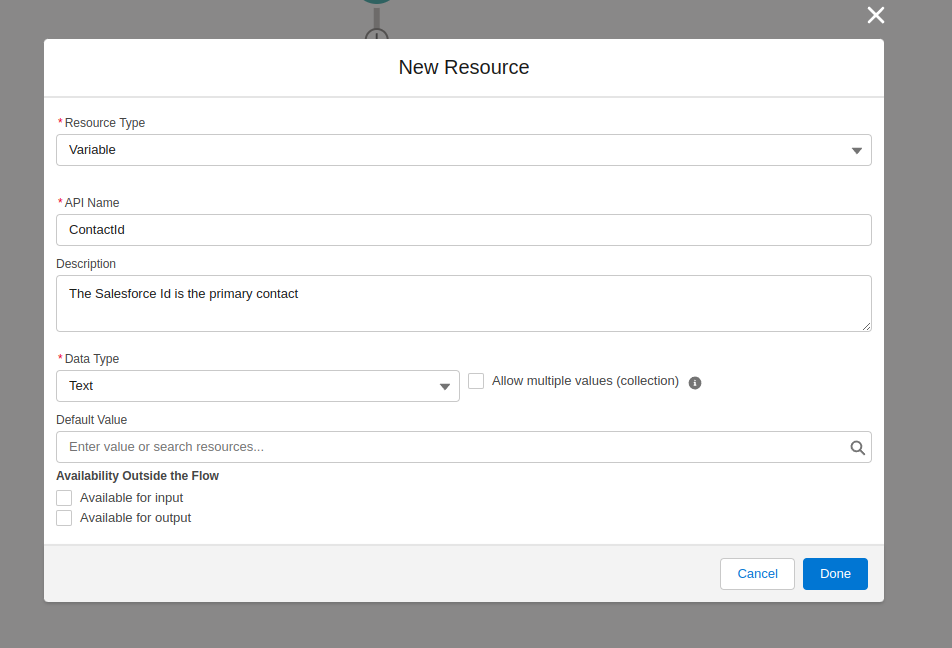
(Optional) Enter a default value for the variable. This value will be used if no other value is provided during flow execution.
7.Now you have a container to store data. You can find it in the Toolbox.
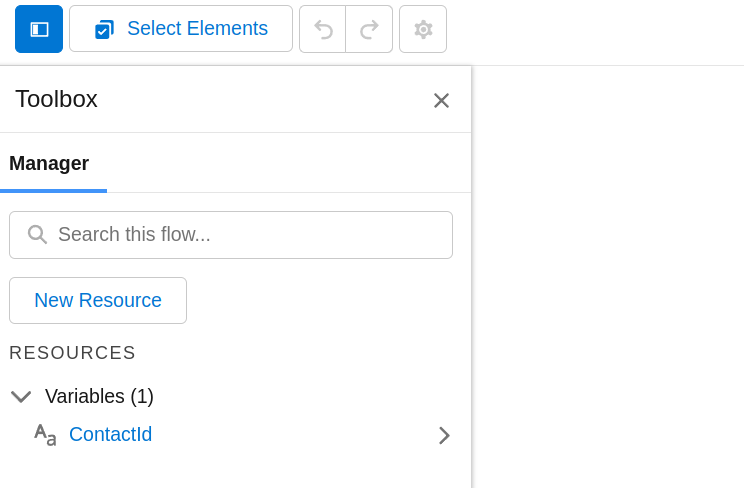
Here are some best practices for creating Flow Variables in Salesforce Flow:
- Use meaningful names for your variables. This will make it easier to understand what data the variable is storing.
- Use the appropriate data type for your variables. For example, if you’re storing a number, use the “Number” data type.
- Keep your variables organized. You can group your variables into categories to make them easier to find and manage.
- Avoid creating too many variables. Having too many variables can make your Salesforce Flow more complex and difficult to manage.
Once you have created a Flow Variable, it can be used throughout the flow to store and manipulate data. In the next section, we will explore how to assign values to Flow Variables.
Assigning Values to Flow Variables
Once you have created a Flow Variable in Salesforce Flow, you can assign a value to it. The value assigned to a Flow Variable can come from user input, record fields, or formulas. Here are some ways to assign values to Flow Variables:
1.Using formulas: You can use formulas to calculate and assign values to Flow Variables. Formulas can be used to perform mathematical operations, concatenate text values, or manipulate date/time values.

2.Setting values from record fields: You can set the value of a Flow Variable to a specific field value from a record. This is useful when you want to extract information from a record and use it elsewhere in the flow.

3.Setting values from user input: You can capture user input and use it to set the value of a Flow Variable. This is useful when you need to gather information from the user in order to complete a flow process.
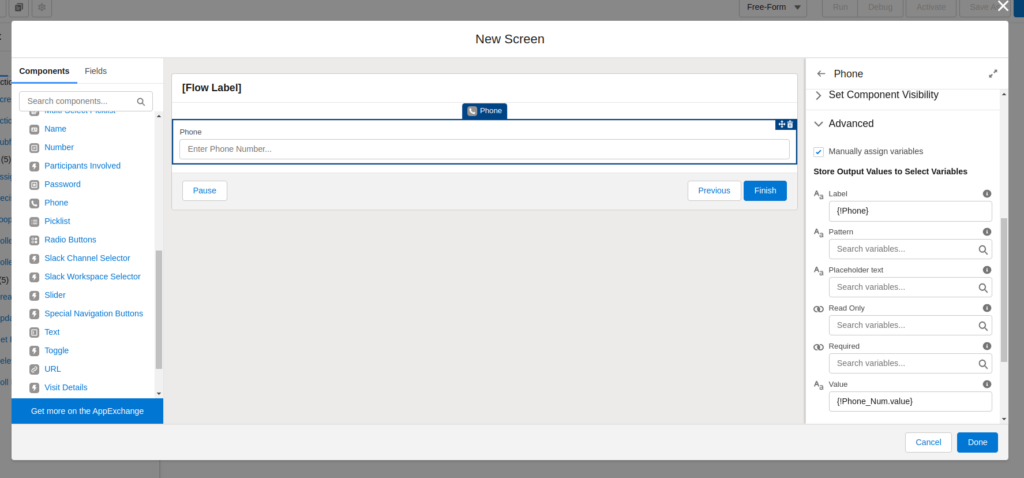
By assigning values to Flow Variables, you can store and manipulate data in a dynamic and flexible way. In the next section, we will explore how to use Flow Variables in Salesforce Flow.
Using Flow Variables in Salesforce Flow

Using Flow Variables in Salesforce Flow is an essential part of building effective and efficient automation processes. Flow Variables can be used in a variety of elements throughout the flow, including screen elements, decision elements, update elements, and Apex actions. Here are some examples of how to use Flow Variables in each of these elements:
- Screen elements: Screen elements allow you to create user interfaces for your flow. You can use Flow Variables to prepopulate fields or provide default values for input fields.
- Decision elements: Decision elements allow you to make conditional decisions based on the data in a Flow Variable. For example, you can use a decision element to determine whether a record meets certain criteria before updating it.
- Update elements: Update elements allow you to update records based on the data in a Flow Variable. For example, you can use an update element to set the status of a record based on the user input captured in a Flow Variable.
- Apex actions: Apex actions allow you to execute custom Apex code in your flow. Flow Variables can be used to pass data between the flow and the Apex code, allowing you to create complex and customized automation processes.
By using Flow Variables in these elements, you can create dynamic and flexible flows that meet your business needs. In the next section, we will explore some best practices for using Flow Variables in Salesforce Flow.
Salesforce Flow Loop Example
A common use case for loops in Salesforce Flow is to process multiple records in a collection. For example, let’s say you have a collection of accounts that need to be updated with a specific value. You can use a loop to iterate through each account in the collection and update the value for each record.
To create a loop in Salesforce Flow, you can use the Loop element. The Loop element allows you to specify the type of loop (For Loop or While Loop) and the condition that controls when the loop will end. For example, you can create a For Loop that iterates through each record in a collection, or a While Loop that repeats a set of actions until a specific condition is met.
Here’s an example of a For Loop in Salesforce Flow:
- Create a new Flow and add a Screen element to collect user input.
- Add a Get Records element to retrieve a collection of accounts.
- Add a For Loop element and specify the collection of accounts to iterate through.
- Add an Update Records element to update each account in the collection.
- Add a Screen element to display a message to the user when the loop is complete.

In this example, the For Loop iterates through each account in the collection and updates a specific field for each record. Once the loop is complete, a message is displayed to the user indicating that the operation was successful.
Salesforce Flow Global Variables
Global variables are a type of Flow Variable that can be accessed from any element in your Salesforce Flow. Global variables are useful when you need to store a value that needs to be accessed by multiple elements, or when you need to pass a value between different sub-flows.
Creating a global variable in Salesforce Flow is easy. Simply create a new Flow Variable and set the Scope to “Global”. Once you’ve created a global variable, you can use it in any element in your Salesforce Flow by referencing it with its name.
https://help.salesforce.com/s/articleView?id=sf.flow_ref_resources_global_variables.htm&type=5
Here are some advantages and disadvantages of using global variables in Salesforce Flow:
Advantages:
- Global variables can be accessed from any element in your Salesforce Flow, making it easy to pass data between different elements.
- Global variables can be used to store values that need to be accessed by multiple elements, reducing the need to create duplicate Flow Variables.
Disadvantages:
- Global variables can make your Salesforce Flow more complex, especially if you have a large number of global variables.
- Global variables can make it more difficult to understand how data is being passed between different elements in your Salesforce Flow.
When using global variables in Salesforce Flow, it’s important to follow best practices to ensure that your Flow is organized and easy to understand. Here are some tips for using global variables in Salesforce Flow:
- Use meaningful names for your global variables to make it easy to understand what data they are storing.
- Only create global variables when you need to pass data between different sub-flows or when you need to store a value that needs to be accessed by multiple elements.
- Be mindful of the number of global variables you create. Creating too many global variables can make your Salesforce Flow more complex and difficult to understand.
In summary, global variables are a powerful tool in Salesforce Flow that can be used to pass data between different elements and reduce the need to create duplicate Flow Variables. When using global variables, it’s important to follow best practices to ensure that your Salesforce Flow is organized and easy to understand.
Best Practices for Using Flow Variables in Salesforce Flow
To ensure that your Salesforce Flow processes run smoothly and efficiently, it’s important to follow best practices when using Flow Variables. Here are some tips for using Flow Variables effectively:
- Use clear and descriptive names for your variables: This will make it easier to understand what the variable is used for and how it should be used in the flow.
- Keep variables as narrow in scope as possible: Don’t create variables that are too broad in scope, as this can lead to confusion and errors. Instead, create variables that are specific to a particular task or process.
- Avoid using too many variables: While variables can be useful, using too many of them can make your flow more complex and harder to understand. Try to keep the number of variables to a minimum.
- Use consistent naming conventions: This will help you and other users to quickly identify and understand the purpose of each variable.
- Use default values where appropriate: Default values can help to streamline your flow by providing a starting point for data when no other value is provided.
- Test your flow thoroughly: Before deploying your flow to production, be sure to test it thoroughly to ensure that all variables are working correctly.
By following these best practices, you can ensure that your Salesforce Flow processes are efficient, effective, and easy to maintain.
Conclusion
Salesforce Flow Variables are an essential part of Salesforce Flow Builder, allowing you to store and manipulate data throughout your automation processes. By creating and using Flow Variables, you can create dynamic and flexible flows that meet your business needs. Whether you are using formulas to calculate and assign values, or setting values from record fields or user input, Flow Variables provide a flexible and powerful way to store and manipulate data in your Salesforce processes.
When using Flow Variables, it’s important to follow best practices to ensure that your flows are efficient and effective. By using clear and descriptive names, keeping variables as narrow in scope as possible, and testing your flows thoroughly, you can create processes that are easy to understand, maintain, and troubleshoot.
In summary, Salesforce Flow Variables are an integral part of building effective and efficient automation processes in Salesforce Flow Builder. By following best practices and using Flow Variables effectively, you can create powerful and flexible automation processes that meet your business needs.